#Indo Arabic Design
Text
Elegant Indian And Arabic Mehndi Designs
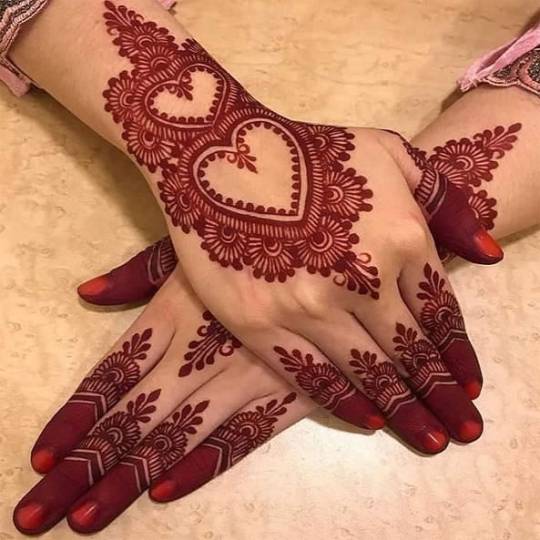

Cultural Significance:
Mehndi plays a pivotal role in various cultural and religious celebrations in India. One of the most prominent occasions for mehndi application is weddings. Bridal mehndi, in particular, is a grand and intricate affair. It symbolizes love, purity, and the beginning of a new chapter in the brides life. The application of mehndi on other auspicious occasions, such as festivals and Karva Chauth, also carries significant cultural meaning.
Regional Variations:
Indias diverse culture and traditions have given rise to a wide array of mehndi styles and patterns. Each region boasts its unique mehndi designs, incorporating local motifs, symbols, and techniques. Whether its the floral patterns of Rajasthan, the bold geometric shapes of Gujarat, or the fine lines of Hyderabad, mehndi designs reflect the rich tapestry of Indian heritage.
The Art of Mehndi Design:
Creating mehndi designs is a skilled and intricate art. Mehndi paste, made from the leaves of the henna plant, is applied to the skin in a decorative manner. The designs often include motifs like paisleys, flowers, peacocks, and intricate geometric patterns. The process is not only a visual spectacle but also a sensory experience, with the earthy scent of henna and the cooling sensation on the skin.
Modern Evolution:
Mehndi designs have not remained static but have evolved to incorporate modern trends. In recent years, there has been a fusion of traditional mehndi with contemporary styles, resulting in designs that are both classic and trendy. The emergence of Arabic and Indo-Arabic styles has added a new dimension to mehndi art, emphasizing minimalism and open spaces in the design.
International Appeal:
Mehndi has transcended its Indian origins to become a global phenomenon. It is now appreciated and practiced in various parts of the world. In the West, mehndi has become a popular form of temporary body art, often adorned at events, parties, and music festivals. The appeal of mehndi lies in its temporary nature, allowing people to experiment with different designs without long-term commitment.
#beauty#makeup#mehndi#bridal fashion#arabic mehndi#india mahndi#Indian style#Floral Design#Rajasthani patten#Shaded designs#Arabic Design#Indo Arabic Design#Pakistani Design#Dulhan Mehndi#Bangle designs#Moroccan design#Mehndi Designs for Legs
1 note
·
View note
Note
YOOOOOOOO your design for damian is so nice! (Love his gamis design)
I was not expecting the halal mention, love how these boys are close to each other still
As a mix of arab indo your service is very appreciated, thank you and keep up the great work 👍🏼
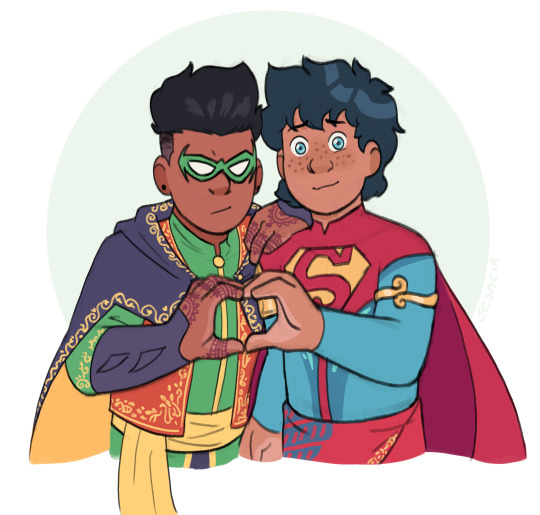
asdfsadf that makes me so happy thank you!! ;_; it just makes sense to me that Damian would still be in touch with his culture and customs!
#askjesncin#supersons#damian wayne#jon kent#robin#superboy#jl remix#my heart grows three sizes bigger whenever anyone sees themselves reflected in my remix guys#that's what art is about baybeee
280 notes
·
View notes
Text

Pentagon confirms start of serial production of the B-21 Raider stealth bomber
The U.S. Air Force recently confirmed that the secret plane continued flight tests at Edwards Air Base.
Fernando Valduga By Fernando Valduga 01/22/2024 - 21:59in Military
After the first flight of the newest stealth bomber of the U.S. Air Force, the Pentagon formally approved the B-21 Raider program to start production, the main Pentagon acquisition officer confirmed today.
"The production of the B-21 'Raider' stealth bomber is advancing. Last fall, based on the results of the ground and flight tests and the team's mature plans for manufacturing, I gave the green light to start producing B-21 at a low rate," the Undersecretary of Defense for Acquisition and Support, William LaPlante said in a statement.
"One of the main attributes of this program has been the conception for production from the beginning - and in scale - to provide a credible impediment to opponents. If you don't produce and put in the field for fighters on a large scale, the capacity doesn't really matter," he added.

First flight of the B-21 Raider.
More details about the value of the contract signature and the delivery dates were not disclosed. The news of the beginning of the bomber's production was first reported by Bloomberg.

Set to replace the B-2 Spirit and the B-1 Lancer, the nuclear-capable Raider is designed for long-range missions with stealth resources that can help you escape enemy air defenses. The U.S. Air Force initially plans to buy at least 100 bombers and put them into service in the mid-2020s.
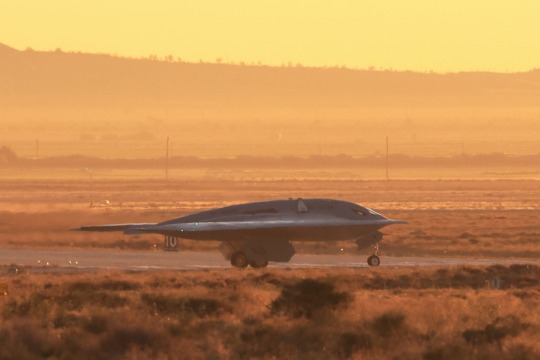
The Pentagon linked the concession of the program's initial low-rate production contract to the aircraft's first flight, which took place in November and was followed by at least one other test flight at Edwards Air Base. However, the executives of the aircraft manufacturer, Northrop Grumman, have long warned that the first batches of production may not be profitable for the company due to inflationary impacts.
The defense contractor is expected to disclose its year-end profits for 2023 on January 25, where investors will probably also be aware of updates on the LGM-35A Sentinel ICBM, the company's other nuclear modernization program that authorities released last week that suffered a "critical cost violation".
Source: Breaking Defense
Tags: Military AviationB-21 RaiderNorthrop GrummanUSAF - United States Air Force / U.S. Air Force
Sharing
tweet
Fernando Valduga
Fernando Valduga
Aviation photographer and pilot since 1992, he has participated in several events and air operations, such as Cruzex, AirVenture, Dayton Airshow and FIDAE. He has works published in specialized aviation magazines in Brazil and abroad. He uses Canon equipment during his photographic work in the world of aviation.
Related news
MILITARY
B-1B bombers perform joint training with Singapore and Japan in the Indo-Pacific
22/01/2024 - 21:00
SAAB
Saab signs GlobalEye support contract with the United Arab Emirates
22/01/2024 - 19:27
HELICOPTERS
First KAI LAH helicopter will be delivered to the South Korean army this year
22/01/2024 - 17:00
ARMAMENTS
German Air Force reinforces arsenal with Brimstone missiles for its Eurofighters
22/01/2024 - 16:00
MILITARY
Denmark will buy long-range drones for surveillance operations in the Arctic
22/01/2024 - 14:00
MILITARY
Romanian pilot performs inaugural flight at the F-16 European Training Center
22/01/2024 - 08:42
16 notes
·
View notes
Text
What is Islamic Architecture?
Islamic Architecture is an architectural style that dominates Muslim-majority countries around the world such as Indonesia, Pakistan, Egypt, Saudi Arabia, Turkey and many more, but is not limited to these locations. Islamic architecture can be found across the globe - though the architecture in other locations may not hold all the main characteristics - there are definite elements that have been incorporated into the western, modern world, (The Spruce., 2022).
This architectural style is associated with the religion of Islam, and has evolved from various other architectural styles like that of Mesopotamian and Roman.
Islamic architecture has several characteristics that are recognisable to even the untrained eye; the use of colour, geometric shapes, symmetry, patterns and calligraphy define the architectural style (Invaluable., 2020). This style of architecture is typically associated with religious establishments in Islam such as the Mosque, but is not restricted to this, the style extends to palaces, tombs, forts and public buildings. One of the oldest elements to identifying Islamic architecture is the presence of Minarets and domes. Minarets are tower-like structures with small windows and enclosed spiral staircases made for muezzins (a man who calls Muslims to pray) to call to worshippers from a high point. The minarets often feature one or more balconies. The forms of the minarets commonly seen range from thick, squat, spiral ramps to soaring, delicate, pencil-thin spires, with the base usually being square in shape. The number of minarets located in a Mosque will vary from one to six and they stand as landmarks of Islam.
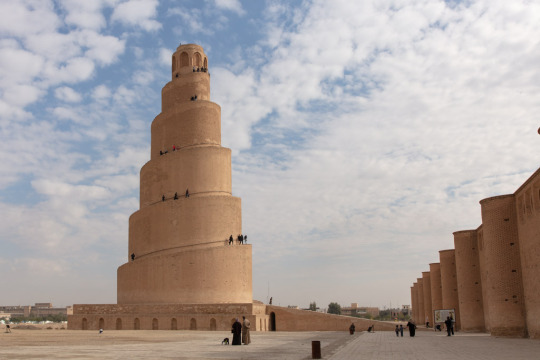
Grand Mosque of Samarra and the spiralling Malwiya Minaret (Adventures of Nicole., 2022).
Domes (like several other architectural movements such as Renaissance and Byzantine) are also a regular feature of islamic architecture.
The first Islamic design featuring a dome is a 7th century shrine in Jerusalem - Dome of the Rock, Arabic Qubbat al-Ṣakhrah. Dome of the Rock was built by Umayyad caliph (chief Muslim civil and religious ruler of the first Muslim dynasty) 'Abd al-Malik ibn Marwān. The structure is situated on a flat elevated plaza known to Muslims as 'The Noble Sanctuary' (al-Haram al-Sharīf), and the rock above which the dome is located is the spot the propet Muhammad was taken up into heaven for an encounter with God (Mi'rāj), (Britannica., 2014).
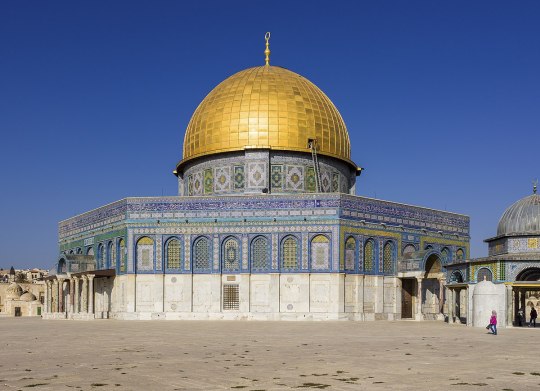
Dome of the Rock, Jerusalem, 691-692 CE.
Most domes rest on pendentives which are constructional devices used to place circular domes over square or rectangular shaped rooms. You can recognise pendentives as Islamic architecture by its decorative tiles or muqarnas - a form of ornamental vaulting, (IvyPanda.,2020).

Diagram of pendentives.

Muqarnas and decorative tiles example.
The most important piece of indo-Islamic architecture os the tomb of the Shah Rukn-i-Alam in Multan. This tomb was built between 1320 and 1324 CE by Giyath al-Din Tughluq in the pre-mughal, architectural style, Giyath was the governor of Diplapor (a city in the Okara District of the Punjab, Pakistan) and is thought to have been built to serve as a tomb for himself. However, it was presented to the family of the renowned Sufi saint Sheikh Rukn-ud-Din Abul Fateh (Sacred Sites., 2020). The tomb is an octagonal shape, 35m high and structured by red brick with a visible frame of beams and shisam wood, and further designed with the use of carved brick, wood blue and white faience mosaic tiles with raised relief patterns. The octagon is decorated with geometric, floral, and arabesque designs and calligraphic motifs. The interior was originally plastered but is now bare and the sarcophagus is surrounded by 72 of his descendants. The saint is still held in high esteem and the tomb is the focus of over 100,000 pilgrims from all over South Asia who visit in order to commemorate his memory, (Unesco., 2004).
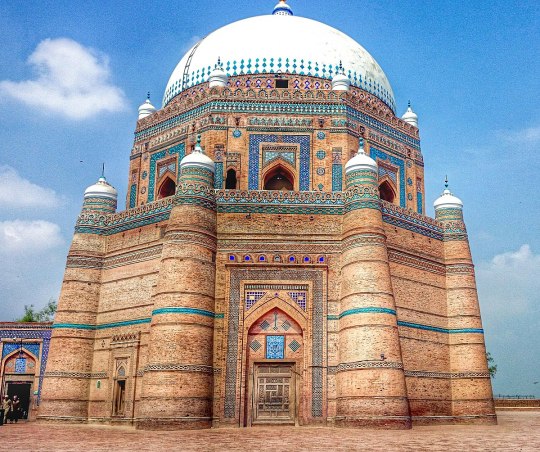
Shah Rukn-i-Alam, Multan, Pakistan.
Arches are yet another prominent feature of identifying Islamic architecture, and their placements usually define the entrances to buildings and rooms. There are several types of arches including: Pointed Arches, Ogee Arches, Horseshoe Arches, and Multifoil Arches. The double arched system of the Mosque-Cathedral of Córdoba, the pointed arches of the Al-Aqsa masque provide excellent examples of how arches become indispensable features of Islamic architecture (Rethinking the Future., 2023).

Double Arches of Mosque-Cathedral of Córdoba
The majority of mosques and palaces falling under the style of Islamic architecture feature courtyards and can house large gatherings of people during festive occasions and prayers. The courtyards will feature fountains for the people to perform ablution before prayers.
Now that there has been an introduction into what it takes to create for Islamic styled architecture, the rest of the blog is open to deeper dives of certain establishments, countries, and architects themselves,
Thank you for reading, I hope you enjoyed!
Summer Marshall-Miller
BIBLIOGRAPHY: Hohenadel, K. (2022) The Spruce. Available at: https://www.thespruce.com/what-is-islamic-architecture-5120474 (Accessed 20 January, 2023)
Britannica, The Editors of Encyclopaedia. (2014) Encyclopaedia Britannica. Available at: https://www.britannica.com/topic/mosque (Accessed: 20 January, 2023)
Unknown Author (2020) Invaluable. Available at: https://www.invaluable.com/blog/islamic-art-patterns/ (Accessed: 21 January, 2023)
IvyPanda (2020) 'Muqarnas in Islamic Architecture'. Available at: https://ivypanda.com/essays/muqarnas-in-islamic-architecture/ (Accessed: 24 January 2023)
UNESCO (2004) Tomb of Shah Rukn-e-Alam. Available at:https://whc.unesco.org/en/tentativelists/1884/#:~:text=The%20tomb%20of%20Shah%20Rukn,saint%20following%20the%20latter%27s%20death (Accessed 7th December 2022).
Unknown Author (2023) Rethinking the Future. Available at: https://www.re-thinkingthefuture.com/architectural-styles/a2589-10-distinctive-elements-of-islamic-architecture/ (Accessed: 23 January 2023).
Nicole Smoot (2022) The Adventures of Nicole. Available at: https://adventuresoflilnicki.com/samarra-iraq/ (Accessed: 23 January 2023).
#architecture#islamicarchitecture#art#history of art#islamic#mosque#history#my blogs#student#major project
33 notes
·
View notes
Text
Yusra Aishwarya // ANKHABHUT X
LOADING DATA ON 'SPIDER' OF EARTH-1610
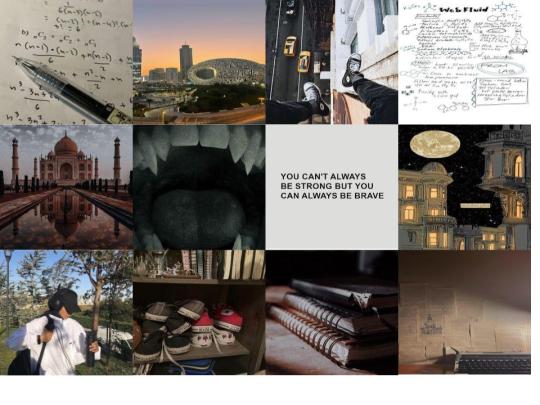
Ankabut - ‘spider’ in Arabic
Bhoot / Bhut - ‘ghost’ in Urdu/Hindi
Yusra : “affluence, success”
Aishwarya : “prosperous wealth”
Age : Currently 16
Height : Currently 6'2" (Projected to be 6'9" due to spider-bite)
Build : Muscular
Race | Ethnicity : South Asian (Indo-Pakistani)
Nationality : Australian - UAE
Religion (if any) : Islam
Sex | Gender : F | she/they
Yusra is currently a 16 year old Muslim student at Verace L.L. Academy - an international private school. Post time-skip, she is a 27 year old grad student of chemical engineering and a fellow at a hospital aiming to become a trauma surgeon. In the end, she does achieve her dreams, but loses quite a few people.
She has dual citizenship in UAE and Sydney, currently living in NYC. Yusra is very well traveled and has even lived in Hong Kong for a few years.
Yusra was bitten when she was 14 in her martial art’s teacher’s wife’s shop. The man had noticed Yusra’s current guardian was late, so he’d stopped on the way home at his wife’s workplace and Yusre got bit there, a unique phenomena amongst the Spiders because she was bit by two radioactive spiders : a sapphire tarantula and peacock jumping spider.
The spiders had initially been at her instructor’s place of work and were meant to bite him and another, but got mixed up in shipping and came to his wife’s pet store as pet spiders. Yusra had a heavily adverse reaction to being bitten and was unconscious for a few days, almost presumed to be dead.
She became ‘Spiderman’ shortly after her and her younger twin sister Zuleika were officially adopted by their great aunt instead of bouncing between relatives and wealthy family members. They had just arrived in New York and started attending school. However, a former student who’d joined an underground cult had broken in with a gun and Zuleika shielded her, dying in the process.
She decided to take up the mantle and her friend, Yu Damian, became her ‘man in the chair’ and designed her web shooters' mechanism. Her suit was inspired by both the spiders that bit her and has gone under many redesigns. It includes a hijab as they are a practicing muslim.
Along with spider sense, stickiness, and superstrength, Yusra has some other abilities such as healing, osteokinesis, super speed, and control over toxins and poisons. These are side effects from her getting bitten by two spiders.
#across the spiderverse#spidersona#spiderman atsv#original characters#spiderwoman#atsv#ghost spider#but not like that lol#oc
5 notes
·
View notes
Text
The "Historical" Disney Costume Rant that Nobody Asked For
To fairly preface this, I am not an expert on Arabian/Middle Eastern culture, pre- or post-Islam. I'm not a fashion historian as in having a degree, only a vaguely passing knowledge and ability to stay up at all hours of the day and night to research obscure topics such as this. However, I am not dismissing or invalidating the feelings of Arabs, Middle Eastern people, or Muslims in regards to Jasmine from 'Aladdin.' I AGREE with them that Jasmine's clothing is neither accurate to the "period" and culture of the Middle East (generally speaking) or appropriate. Jasmine's costume design is viewed through the lens of orientalism, exoticism, and stereotypes of Middle Eastern and Arabian culture.
HOWEVER...
I take issues with this design:
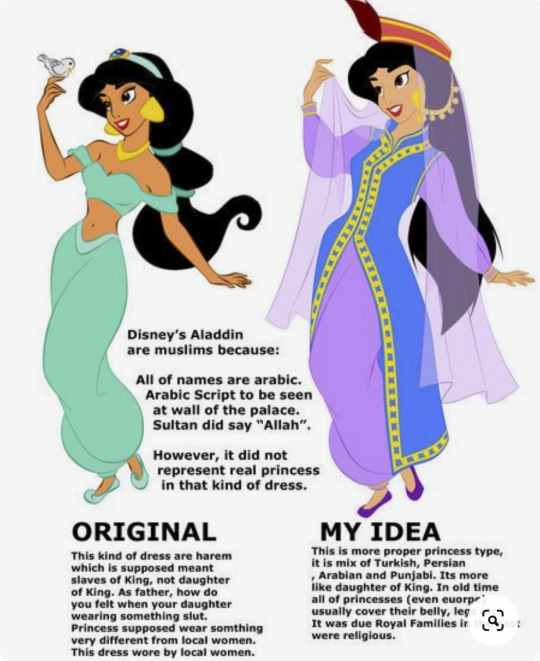
Original Pinterest Post here
Right off the bat, could we not have slut-shamming, please? For five minutes? I understand that 16 year old Jasmine probably shouldn't be exposing that much shoulder and midriff, but that's not a call for slut-shaming. Could we not?
From what I can find, not even slaves or concubines wore the kind of things Jasmine does in any period of the Middle East or Arabia. Her father wouldn't be called "king," he'd either be Shah or Sultan, but that's just a tiny nitpick for me. The meat of the issue for me is the "information" provided between the two figures.
There's not concrete evidence that the characters of Aladdin are Muslims just because they use Arabic names, though some of those names aren't, in fact, Arabic.
Jasmine = Persian (Indo-Iranian dating back to the 5th century BC)
Iago = Spanish
Rajah = Sanskrit
Arabic wasn't invented in the 7th AD. The language is a branch of the Semitic language and emerged around the first century BC. The Arabic word for "God", Allah, is older than Islam. Evidence has shown that "Allah" has been around since at least the 5th century BC. Which makes it entirely possible that use of the word Allah and Arabic names does not definitely indicate that Aladdin takes place after 6th-7th century AD Middle East. Furthermore, I have a suspicion that it takes place much, much earlier than that. Being as old as I am, I have some canon that younger Disney fans might not know. Back in the day (late 1990's and early 2000's), Disney produced cartoon series for Aladdin and Hercules around the same time. Aladdin and Hercules CANONICALLY meet in a crossover episode of their series in an episode of Hercules, "Hercules and the Arabian Nights," which aired in February 10, 1999.
Source 1
Source 2
Since Hercules and Aladdin have canonically met in the same universe, it can only mean that Aladdin takes place in, at least, the Bronze or Iron Age alongside Ancient Greece.

Ergo, the characters in Aladdin do not necessarily represent Middle Eastern or Arabian Muslims from the 7th century AD and beyond. If we were going to set Aladdin in a more "historically accurate," Agrahba would take place in either a multicultural pagan Middle East or one ruled mostly by Zoroastrians, which is equally misunderstood and underappreciated by the West as Islam.
But I have digressed far enough. It kind of bothers me that Jasmine is repainted to be so much "fairer" looking. Not all Arabs or Middle Eastern groups have dark skin, but making her paler to make her appear "better" is...certainly a choice. Furthermore, Arabian and Middle Eastern costumes vary by region, but all are beautiful and colorful.
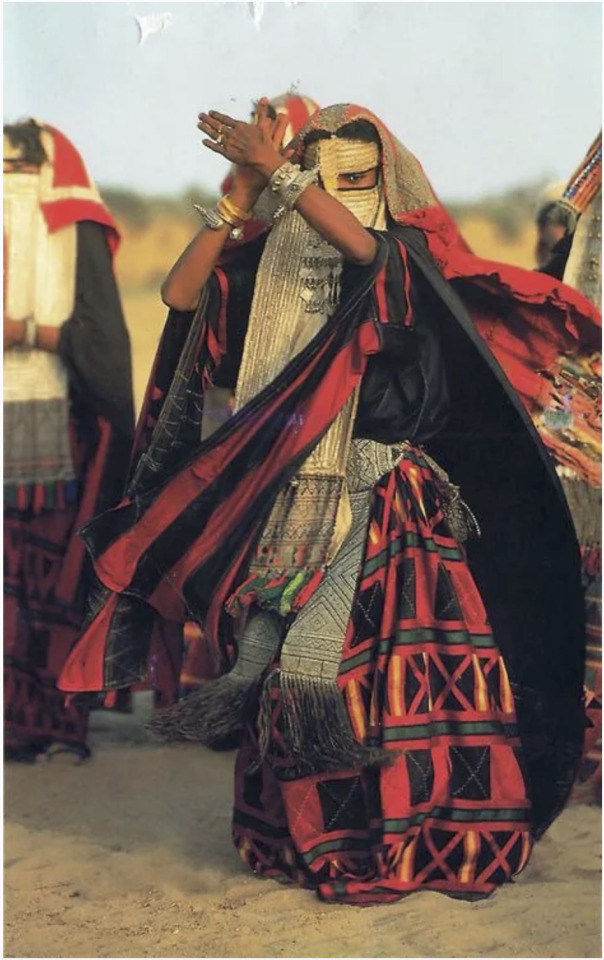
Source

Source
Turkish is not the same thing as "Arabic." For example:
And if we consider pre-Islamic fashion, Jasmine probably would dress more like this:
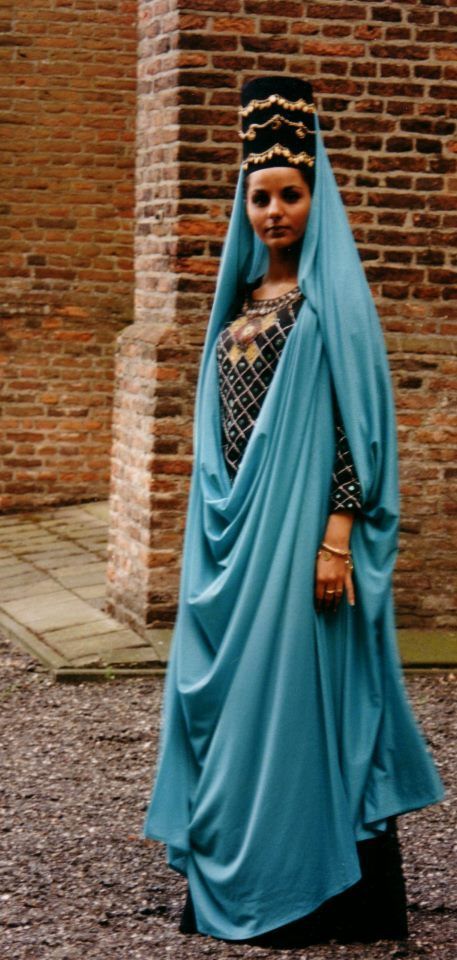
Supposedly, this is a recreation of Parthian dress (Parthian Empire, 247 BC-224 AD).
Combining different cultures such as Turkish, Arabic, Punjabi, and Persian together does the historic costuming of Arabic, Persian, and the Middle East in general a great disservice. The Middle East is not a monolith of culture just because currently it is majority practicing Muslims. Punjab is on the other side of the Indus Valley, and it's Indo-Aryan (not THAT Aryan) in origin, not Arabic. Curious why it's included beyond the fact that many Punjabi today are Muslim.
I'm really not trying to bash the artist here. They have the right idea, but I think with a little more research creating a "new" Jasmine would be far more interesting than pulling from various cultures around the Middle East and Islamic cultures from different regions and slap them together. Thank you for hearing me needlessly ramble coming to my TED Talk.
5 notes
·
View notes
Text
Mehendi Designs for Indian Festivals and Celebrations
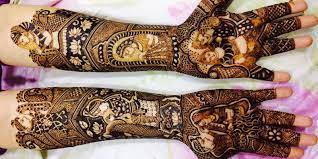
Mehendi, also known as henna, holds a significant place in Indian culture, especially during festivals and celebrations. It is not just a form of body art but a symbol of joy, auspiciousness, and tradition. The intricate designs crafted with henna hold deep cultural and religious significance, adding an element of grace and beauty to every occasion. In this article, we delve into the rich heritage of Mehendi designs and explore their relevance in Indian festivals and celebrations.
The Tradition of Mehendi in India
The tradition of applying Mehendi dates back centuries in India, with its roots deeply embedded in Hindu and Muslim customs. It is an integral part of various ceremonies and celebrations, including weddings, festivals like Diwali, Eid, Karva Chauth, and other auspicious occasions. Mehendi is not just a form of adornment but is believed to bring good luck and prosperity.
Intricate Mehendi Designs
Mehendi designs are characterized by their intricate patterns, which are often passed down through generations. These designs vary from region to region, with each style reflecting the cultural diversity of India. From traditional motifs like peacocks, flowers, and paisleys to modern geometric patterns, Mehendi artists showcase their creativity through a myriad of designs.
Significance in Indian Festivals
During Indian festivals and celebrations, Mehendi holds a special significance. It is considered auspicious to adorn one's hands and feet with Mehendi during festivals like Diwali, where it symbolizes prosperity and good fortune. Similarly, during Eid, Mehendi is an essential part of the celebrations, especially for women, who adorn their hands with intricate designs as a mark of festivity.
Weddings and Mehendi Ceremonies
Weddings in India are incomplete without Mehendi ceremonies, which are celebrated with much fervor and joy. It is customary for the bride and her female relatives and friends to apply Mehendi as part of pre-wedding rituals. The designs are often elaborate, covering the bride's hands and feet with intricate patterns symbolizing love, happiness, and marital bliss.
Evolution of Mehendi Designs
Over the years, Mehendi designs have evolved, blending traditional motifs with contemporary styles. Mehendi artists experiment with various techniques and styles, incorporating elements of fusion and creativity. From Arabic and Moroccan designs to Indo-western fusion patterns, the world of Mehendi has witnessed a transformation, catering to diverse preferences and tastes.
Buying Mehendi Powder in India
When it comes to buy Mehendi powder in India one can find a plethora of options available both online and offline. Rajasthan, known for its rich heritage of henna cultivation, is home to numerous Henna powder manufacturers in rajasthan and Natural Henna powder online sourced from Rajasthan is highly revered for its quality and purity.
Popular Mehendi Designs
Mehendi designs vary from region to region in India, each reflecting unique cultural influences and traditions. Some of the popular Mehendi designs include:
Rajasthani Mehendi:
Known for its elaborate patterns and motifs, Rajasthani Mehendi designs often feature peacocks, flowers, and intricate detailing. These designs are characterized by bold outlines and filled patterns, creating a stunning visual impact.
Arabic Mehendi:
Arabic Mehendi designs are characterized by their free-flowing, floral patterns and geometric shapes. These designs typically feature large, bold motifs with minimal shading, creating a striking contrast against the skin.
Indian Traditional Mehendi:
Traditional Indian Mehendi designs are characterized by intricate patterns that cover the entire hand and extend to the forearm. These designs often incorporate elements like paisleys, mango motifs, and floral patterns, symbolizing fertility, prosperity, and love.
Bridal Mehendi: Bridal Mehendi designs are the most elaborate and detailed, covering the entire hands and feet with intricate patterns. These designs often include motifs that are specific to weddings, such as bride and groom figures, wedding symbols, and personalized elements representing the couple's love story.
Modern Mehendi:
Modern Mehendi designs often incorporate contemporary elements such as abstract patterns, geometric shapes, and fusion designs. These designs cater to individuals looking for a unique and trendy twist on traditional Mehendi art.
Conclusion
Mehendi designs hold a special place in Indian festivals and celebrations, embodying the cultural richness and tradition of the country. From weddings to religious festivals, Mehendi adorns the hands and feet of millions, symbolizing joy, prosperity, and auspiciousness. With its intricate patterns and timeless elegance, Mehendi continues to captivate hearts, making every occasion truly memorable. So, embrace the beauty of Mehendi and celebrate the essence of Indian culture with its mesmerizing designs.
0 notes
Link
0 notes
Text
HISTORY OF PAKISTAN CLOTHING - TRAVELING THROUGH TIME
Culture and fashion are vital parts of any country’s history and civilization. In Pakistan, both of these are inextricably woven. To understand Pakistan’s fashion, we’ve compiled this brief guide to help take you back in time.
The history of Pakistan dresses is a very colorful and interesting one.
This history not only makes for a great learning experience but also gives insight into everything you need to know to understand why Pakistani fashion is where it is today. As you’ll see, this history of fashion in Pakistan reflects the culture, ideologies, and evolution of the Pakistan people, over time.
Designer Pakistani Suit in Green
ORIGIN OF PAKISTANI DRESSES
Based on historical discoveries, Pakistani dresses date back over 7,000 years ago to the Bronze Age. This was during the Indus Valley Civilization era when cotton was first cultivated around 3,000 BC in the Indus River Valley which is now present-day Pakistan.
Pakistan’s geostrategic location also played a big role in its fashion and culture.
The country is bordered by India on the east, Iran by the west, Afghanistan in the northwest, China by the northeast, and the Arabian sea towards the south. This has made Pak nation a great connection point for trade and civilization through history. But then, this has also made it a favorite invasion route for foreign countries through centuries, as well.
Floor length Pakistani Dress
Some of the past invasions, occupation, and settlement in Pakistan have involved diverse foreign cultures from Persians to Arabs, Turks, Mongols, Aryans, Dravidians, Greeks, White Huns, and certain Eurasian groups, among others.
For the country, this has meant the marriage of many cultures with the fashion mainly a blend of both Afghan and Persian elements. Along with this, fashion choices in Pakistan have also been shaped by religious considerations. This marriage of cultures, as well as the religious undertones, explains why Pakistani dresses seem exotic.
MUGHAL ERA INFLUENCE ON PAKISTANI FASHION
The Doab continued to suffer continuous Mongol occupation towards the end of the 13th century. The region (present-day Pakistan) was sacked as early as 1303. Fast forward to the 16th century, the Mughals have seized control and ruled most of India and Pakistan.
The Mughals (who are Muslims of Turkic-Mongol origin) consolidated Islam in South Asia. But along with spreading their faith, the Mughals also spread their Persian arts and culture. This cultural influence can easily be seen today with the majority of Pakistani clothing being a fusion of traditional and Mughal cultures.
The Mughal era in South Asia is perhaps the single most influential era in the history of Pakistani fashion. This can be seen in the contemporary costumes of Pakistan from the Pakistani Salwar Kameez which is the national dress, to the lehenga, turban, churidar pajamas, pishwas, etc.
A Pakistani Dress for Girls
Many of these dresses have their origins traceable to the Mughal era although they have also evolved, over time.
ORIGIN & EVOLUTION OF THE SALWAR KAMEEZ - PAKISTAN’S NATIONAL DRESS
The Salwar Kameez was introduced to the Indo-Pak subcontinent in the 12th century along with the arrival of Muslims in South Asia. Fast forward to the 16th century when the Mughals held control of the region, the dress, along with several other elements of Persian art and culture had seeped into the region.
The earliest known form of Salwar Kameez is the Anarkali Salwar Kameez.
The Anarkali itself was first worn by Mujra dancers, courtesans who were often invited into the Mughal palace to entertain the royalty with Mujra dance steps. While the dress was originally known as the Mujra dress, it was renamed after Lady Anarkali (the legendary Mughal courtesan), upon her death.
The Salwar Kameez has survived centuries of changes and evolution to remain the favorite choice of dress for men and women in Pakistan today. The Pakistani salwar has a long and straight cut and is usually paired with the salwar or churidar pants.
A Pair of Pakistani Dresses
Pakistani women pair theirs with a dupatta shawl that helps to cover the head. The dress is super comfy and allows for maximal movement. This comfort and ease perhaps explain why it has held its place steadfastly as Pakistan's national clothing after all of these years.
MODERN ERA FASHION IN PAKISTAN
Pakistan’s social and political trajectory was on a very different path at the turn of the 20th century. The Mughal Empire began crumbling around the mid-19th-century and by 1858, the British deposed Emperor Bahadur Shah II, the twentieth and last Mughal Emperor of India, effectively ending the reign of the Mughal dynasty.
The British Raj ruled the Indian subcontinent from 1858 to 1947 when both India and Pakistan got independence. As expected, all of these moments in history had impacts on the culture and fashion of the people. As of the 20th century, the fashion choices here mostly reflect Indian cultures and traditions.
In the early 1900s, sarees and ghagras ruled the scene alongside the salwars, of course. After secession and independence, however, the Pakistani fashion scene longed for a distinct identity from its mainly Indian influence. Pakistani fashion became more liberal and tasteful around the mid-20th century. Western influence at this point meant dresses were shorter, half calf trousers and bell bottoms became more common.
Women in Pakistani Chiffon Suits
Towards the end of the 20th century, long shirts became more common.
Later on, the martial law to wear religious appropriate clothing was introduced by General Zia-ul-Haq paving the way for lengthier scarves and longer shirts. By the end of the 20th century, however, half sleeves became a thing again, with women styling their hair in bob cuts.
Along with the traditional salwar kameez, wide-leg pants, cigarette pants, jeans, and tights all showed up on the scene. Today, modern Pakistani fashion reflects all of the progressiveness and cultural nuances, and diversity of this 200 million population country. The fashion scene is as diverse as it’s ever been. Pakistani women now have their very own distinct fashion identity that most people can relate to.
0 notes
Text
best suits for men in bangalore
INTRODUCTION
TRENDING TRADITIONAL WEARS FOR EVERY FESTIVE OCCASION:
Embracing ethnic and traditional wear is a perennial style choice. Donning traditional Indian-inspired clothing offers a distinctive way for men to stand out and exude style in 2022. Explore these exceptional traditional Indian outfits that speak volumes. Whether it's a holiday season or a special occasion, these looks are curated to ensure you look your best, standing out confidently from the crowd. To enhance your style, consider exploring the best suits for men in Bangalore, ensuring a tailored and sophisticated appearance for any celebration.
WEDDING ATTIRE BY DRESS CODE:
Weddings often bring the choice of attire, sometimes based on dress codes set by the couples or left to individual preferences. Discovering the perfect outfit for an upcoming wedding party involves navigating through various styles. Whether you opt for a thematic approach or individual choice, finding the right ensemble is crucial. To elevate your wedding attire, explore the options provided by the best suits for men in Bangalore. Tailored to perfection, these suits add a touch of sophistication to your wedding look, enhancing the overall celebratory experience.
Jodhpur Pants and a Kurta:
Jodhpuri fashion imparts a cultural touch and a remarkable appearance. Enhance your ensemble by incorporating mojdis with Jodhpuri pants and a kurta, creating a fashionable and attractive look. Opting for a dark kurta paired with neutral-colored Jodhpuri trousers is visually appealing. Elevate your style by accessorizing kurtas with patterns, geometrical shapes, and decorations, making it an ideal choice for weddings and festive seasons. The addition of golden, silver, and gemstone buttons, coupled with exquisite embroidery work, contributes to an incredible appearance. Explore the best suits for men in Bangalore to complement this traditional outfit, ensuring a sophisticated and tailored look for any occasion.
Sherwani:
The sherwani, a knee-length jacket with a collar, center front opening, and slit, is a popular choice for grooms. Worn over a kurta, it can be paired with various bottom wear options, such as jodhpurs, trousers, pajamas, churidars, dhotis, or fitting pants, creating an exquisite appearance. Sherwanis often feature intricate stonework and motifs, drawing inspiration from the Mughal period. With diverse styles available, from basic to intricate designer Indo-Western forms, the traditional menswear category showcases some of the most inspired clothing. Explore the best suits for men in Bangalore to enhance your sherwani ensemble, ensuring a refined and polished look for weddings and special occasions.
Pathani Suit:
Inspired by traditional garments from Arab countries, the Pathani Suit offers an elegant and casual look suitable for festive occasions. Consisting of a long kurta with a collar, front pockets, and baggy salwar trousers, it features rounded hems and a button placket. Typically crafted from cotton fabric, Pathani suits can be elevated by pairing them with loafers or moccasins, taking your ethnic style to another level. Consider exploring the best suits for men in Bangalore to find the perfect complement for your Pathani Suit, ensuring a well-coordinated and sophisticated appearance.
Dhoti/Mundu from Kerala:
A common outfit among South Indians, the dhoti or lungi, is made of cotton or silk, often in white, off-white, or ivory with a thin golden border. Stretched to cover the legs and wrapped around the waist with tucked-in pleats, it exudes simplicity and cultural richness. Ideal for weddings or cultural events, pair your dhoti ensemble with the best suits for men in Bangalore to add a touch of sophistication, creating a harmonious and visually pleasing atmosphere for the celebration.
Indo-Western Groups:
Since the British era, Indo-Western clothing has dominated Indian fashion, blending ethnic elements with a contemporary touch. These outfits enhance and distinguish the overall appearance. Featuring modern designs, such as printed long coats with symmetrical or cowl hemlines, Indo-Western groups have gained popularity, offering a fashionable and upscale appearance to men. Explore the best suits for men in Bangalore to complement your Indo-Western ensemble, ensuring a seamless and stylish overall look for any occasion.
Men’s Ethnic Wear Accessories:
It's a common misconception that accessories are exclusively for women. Contrary to this belief, men have a plethora of accessory options available today, leaving them spoilt for choice. The right accessories can be game-changers, significantly impacting a man's wardrobe and fashion sense. However, a word of caution—while accessories have the power to elevate your style, it's essential to exercise restraint to avoid going overboard. To enhance their ethnic appearance, men can explore the best suits for men in Bangalore. These accessories are curated to captivate attention and refine the overall look, ensuring a stylish and well-coordinated ensemble.
The Power of Accessories:
Don't be misled into thinking that accessories are reserved solely for women. Men now have a wide array of options that can be overwhelming. The correct accessories possess the transformative ability to greatly influence a man's wardrobe and fashion sensibility. It's crucial, however, to exercise moderation to prevent an excessive look. Here, we present the best accessories for men in conjunction with the best suits for men in Bangalore. These accessories are carefully chosen to not only enhance ethnic wear but also to attract attention and elevate the overall appearance, making a bold fashion statement.
Enhancing Your Ethnic Appearance:
To assume that accessories are exclusive to women is a misconception. Men today are presented with an abundance of accessory options, each with the potential to redefine their style game. The strategic use of accessories can significantly impact a man's wardrobe and fashion perception. Yet, a word of caution is necessary to prevent excessive accessorizing. Here, we introduce the best accessories for men, complementing the best suits for men in Bangalore. These accessories are designed to enhance the ethnic appearance, ensuring that men stand out and garner attention with a refined and well-coordinated ensemble.
Caution in Accessorizing:
Gone are the days when accessories were considered a female domain. Today, men have an overwhelming array of options that can be game-changers in their style journey. Accessories wield the power to influence a man's wardrobe and fashion sense, but moderation is key to avoid an overwhelming look. Here, we present the best accessories for men alongside the best suits for men in Bangalore. These accessories are carefully selected to add finesse to ethnic wear, striking a balance that captivates attention without going overboard, ensuring a sophisticated and stylish appearance.
Attracting Interest with Accessories:
If you thought accessories were exclusive to women, think again. Men are now presented with a myriad of accessory options that can be both exciting and overwhelming. The right accessories possess the ability to transform a man's wardrobe and sense of fashion, but it's essential to exercise caution to avoid a cluttered look. Introducing the best accessories for men in tandem with the best suits for men in Bangalore. These accessories are thoughtfully chosen to enhance the ethnic appearance, ensuring that men not only attract interest but also exude confidence with a meticulously curated and stylish ensemble.
CONCLUDING
__________
Embrace the art of making cherished memories through impeccable dressing. For the ultimate destination in procuring men's traditional clothing online with expert tailoring services, Royal Mens Wear and Textiles stands out. Experience unbeatable discounts and exclusive offers for personalized stitching services at this one-stop-shop. Explore the world of men’s traditional clothing styles at Royal Men’s Wear and Textiles. Seize the opportunity to discover the best suits for men in Bangalore, ensuring a tailored and refined appearance for every significant moment.
0 notes
Text
3000 BC:
The oldest beer in Europe, dating back to 3000 BC, is found in Can Sadurní Cave in Begus (Barcelona).
1100 BC:
The Phoenicians begin to make wine from grapes in Spain, kicking off the Spanish grape culture.
1000 - 300 BC:
Spanish wine is widely traded in the Mediterranean and North Africa, laying the foundation for a regional wine culture.
Roman Period (300BC - 500):
The Romans conquer Spain, introducing new winemaking methods and styles. However, the wine industry suffers with the collapse of the Roman Empire.
8th Century:
Arab invasions bring religious prohibitions on alcohol, but wine continues to flourish during the Middle Ages.
12th century:
The first beer societies appeared and beer was used as a food supplement for pilgrims and the sick, these institutions were controlled by monasteries and gradually evolved into the so-called "abbey beers".
1561:
Madrid is chosen as the capital, increasing the demand and production of wine and fuelling a boom in related industries.
16th century:
Charles V introduces beer more forcefully, bringing with him master brewers, which gradually spreads to Spain.
The first brewery is founded in Madrid, marking the beginning of the beer industry in Spain.
17th century:
Wine was seen as an essential product in the diet of the common man, providing calories and offering greater hygiene in areas where water sources were unsuitable.
1868:
Bordeaux grapes suffer a phylloxera disaster and French winemakers move to Spain, introducing new techniques and ushering in a period of prosperity for Spanish wine and beer.
Late 19th century:
Breweries begin to flourish at the end of the 19th century, ushering in a boom period for the beer industry.
20th Century:
Spain experiences war and economic disruption, but winemakers gradually improve quality, join the European Union and set new standards for wine regulations.
1972:
Spain's Ministry of Agriculture establishes the Instito de Denominaciones de Origen (INDO), creating the Denominaciones de Origen (DO) monitoring system.
1986:
Addition of the Denominaciones de Origen Calificada (DOC) class, of which Rioja is the only DOC class.
Today:
Spain has 55 DOs ("Designation of Origin"), 20 of which were approved in 1994. the Rioja is the only DOC class with a minimum ageing time, including the Reserva and Gran Reserva classes. Spain's wine culture continues to be important in contemporary society.
0 notes
Text
How many types of Mehendi designs are there?
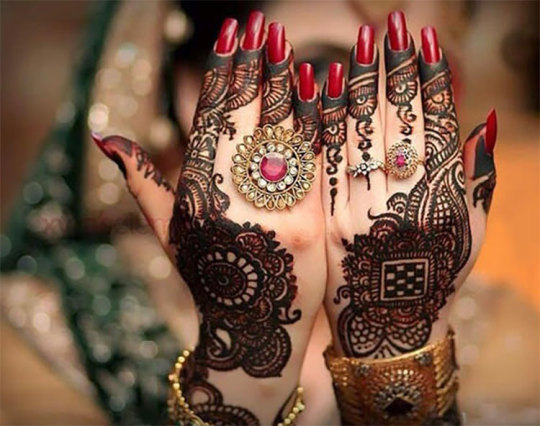
There are several types of Mehandi designs, each with its own distinct style and cultural significance. Here are some of the most prominent types:
Indian Mehandi Designs
Known for their intricate and detailed patterns, Indian Mehandi classes often include motifs of peacocks, flowers, paisleys, and other traditional symbols. These designs are usually bold and cover the entire hand and sometimes extend to the forearm and upper arm.
Arabic Mehandi Designs
Arabic designs are characterized by their larger floral motifs and open spaces. They typically feature bold lines and leaves, creating a more minimalistic and elegant appearance. These designs are often concentrated on the hands and leave the fingertips clear.
Moroccan Mehandi Designs
Moroccan designs often incorporate geometric shapes and patterns. These designs are known for their symmetry and may include diamonds, triangles, and other angular elements.
Pakistani Mehandi Designs
Pakistani Mehandi designs often combine elements of Indian and Arabic styles. They feature intricate patterns that cover the hands and arms, with a focus on fine lines and paisley motifs.
Indo-Arabic Mehandi Designs
As the name suggests, these designs are a fusion of Indian and Arabic styles. They combine the boldness of Indian patterns with the elegance of Arabic designs, creating a unique and visually appealing look.
Bridal Mehandi Designs
Bridal Mehandi designs are elaborate and intricate, often covering the hands and extending up the arms and legs. These designs can include personalized elements such as the couple's initials, wedding dates, and other symbols of significance.
Rajasthani Mehandi Designs
Originating from the state of Rajasthan in India, these designs are characterized by their fine lines and intricate patterns. They often depict motifs of peacocks, flowers, and traditional Rajasthani elements.
Gulf Mehandi Designs
Popular in the Gulf countries, these designs are a blend of Arabic and Indian styles. They feature bold patterns and can be quite elaborate, often covering the entire hand and sometimes the feet as well.
0 notes
Text
Explore Nandita Mahtani's Impact on Indian Fashion Industry
Nandita Mahtani has been a force to be reckoned with in the Indian fashion industry. As a prominent designer, she has captured the hearts of fashion enthusiasts and celebrities alike with her distinctive design philosophy and her ability to seamlessly blend Indian and Western styles. This article offers a comprehensive exploration of Nandita Mahtani's impact on the Indian fashion industry, detailing her remarkable journey and highlighting some of the designer's most prominent works that have left an indelible mark on the fashion landscape.
Reinventing Fusion Wear: A Modern Approach
In a world where fashion designers constantly push boundaries to create innovative styles, Nandita Mahtani has set herself apart by embracing and redefining fusion wear. Her distinctive approach of blending Indian and Western elements has not only resonated with modern Indian women but has also put her in the international spotlight. Some of her notable fusion wear creations include:
Embroidered Tunic Dresses: By incorporating Indian embroidery techniques, such as zardozi or mirror work, on modern tunic dresses, Nandita skilfully merges both traditional and contemporary fashion sensibilities.
Indo-Western Gowns: Her gown designs often feature intricate Indian motifs on flowing silhouettes, making a statement on red carpets and the wedding circuit alike.
Ethnic Crop Tops and Skirts: Merging Western crop tops with traditional lehenga skirts, Nandita creates a youthful, contemporary look that appeals to younger generations.
With her unique fusion wear designs, Nandita Mahtani has successfully pushed the envelope in terms of re-imagining conventional Indian wear, making her a trendsetter in the ever-evolving fashion landscape.
Dressing Bollywood: Design Statement and Influence
Nandita Mahtani's fashion prowess has not gone unnoticed by Bollywood's leading ladies, who often turn to her for their red carpet looks, public appearances, and even personal wardrobes. Her clientele includes industry stars and fashion icons such as Anushka Sharma, Bipasha Basu, Malaika Arora, and Shilpa Shetty. Dressing some of India's most influential figures has significantly bolstered Nandita's impact on the Indian fashion industry, transforming her into a sought-after designer and a style inspiration for millions of fans.
A Global Fashion Ambassador: Promoting Indian Design Aesthetics
Nandita Mahtani's unique design philosophy and consistent quality have garnered not just national appreciation but have also catapulted her to international recognition. Her designs are retailed across the globe in countries like the United States, the United Kingdom, the United Arab Emirates, and others. By collaborating with various celebrities and participating in international fashion weeks, Nandita actively promotes Indian design aesthetics on a global platform, thereby making a significant impact on how the world perceives Indian fashion.
Empowering Aspiring Designers: An Inspiring Journey
Nandita Mahtani's inspiring journey from an aspiring designer to an iconic name in the fashion industry is a testament to her hard work, determination, and relentless pursuit of her passion. By establishing herself as a leading designer and creating a niche for fusion wear, she has inspired countless aspiring designers to chase their dreams and persist in the face of adversity.
Concluding Thoughts: A Sustained Contribution
Nandita Mahtani's impact on the Indian fashion industry is undeniably profound. Her visionary creations, devotion to quality, and ability to reinvent fusion wear have cemented her place as a driving force in the realm of fashion. By dressing influential personalities, promoting Indian design aesthetics globally, and inspiring the next generation of aspiring designers, Nandita Mahtani's legacy in the fashion world continues to grow, proving that her unique style and fashion ethos are more than just a passing fad but a lasting, transformative force in the world of Indian fashion.
1 note
·
View note
Text
Coins Of India |Old India Coins

India has a rich history of coinage dating back thousands of years. Over the centuries, various kingdoms and empires issued their own coins, each reflecting the cultural, and economic influences of the time. India has Notable coins including punch-marked coins from the 6th century BCE, Mauryan Empire silver and copper coins, Indo-Greek coins with Greek and Indian designs, Gupta Empire gold dinars, Mughal Empire coins featuring calligraphy and Arabic inscriptions, British India coins, Commemorative, Mahatma Gandhi coins and modern coins of the Republic of India featuring national symbols and many more dynasties historical figures collectibles.
Would you be interested in adopting and collecting Indian coins, we are giddily Inviting you to India's Premium & Trusted online platform to Buy and Sell Stamps, Old Coins, Banknotes, Medals, and many more Antique and Ancient collectibles.
Visit our website: www.novelemporium.com
Call Us: 78294 10063 / 88670 29800
0 notes
Text
9 Exciting Things To Do On Your Trip With Customized Singapore Tour Packages
Off the coast of Malaysia, the city-state of Singapore is stunning. Singapore serves as a gateway to the nations of Southeast Asia and receives a vast number of tourists every year. Because of the experiences it provides, it is a popular vacation spot with people all over the world. One can engage in a wide variety of activities here. Swimming and other water sports are available at the beaches, and Sentosa and Universal Studios both offer exhilarating rides. In addition to this, one can also stroll through the nearby neighbourhoods. One of them is Kampong Glam, and the amazing things to do in Kampong Glam are listed below. Continue reading to find out what you can do during your trip with our Customized Singapore Tour Packages.
Singapore's Kampong Glam is a quiet district that is located on the north Singapore River. It is frequently referred to as the Malay-Muslim quarter and is situated in Rochor's planning district. Check out the activities that you can do here.
9 Best Things To Do In Singapore
1. Masjid Sultan
Visit Masjid Sultan on Muscat Street if you're looking for things to do in Kampong Glam. It is located in Singapore's Kampong Glam neighbourhood. It is a magnificent sight. The mosque's construction lasted four years and featured minarets and balustrades in its design. This building's architecture is in the Indo-Saracenic style. It was declared to be a national monument in 1975, and it is now one. If you visit Kampong Glam, be sure to include it in your city tour. After you visit this place with our Customized Singapore Tour Packages. you can go to one of the upscale cafes that are located close to the mosque.
2. Arab Street
A top activity in Kampong Glam is strolling around Arab Street. On a cool Singaporean evening, you should stroll around this area. The tranquil atmosphere of this place is enhanced by the Masjid Sultan on Muscat Street. It is a great location for clothing shopping. Arab Street is home to some incredible fabric stores. In addition, if one wants to unwind, there are some massage clinics nearby. When visiting Singapore, make sure to visit this street and stay for a lovely evening. The Haji Lane and Bali Lane are additional areas to explore in this area. Here, you might find some oddball items to bring home that you wouldn't find anywhere else.
3. Haji Lane
This lane offers everything for leisure time, from charming cafes to breathtaking murals. Even the crowd is quite diverse in this location, with young photographers, middle-aged women lounging around in casual undresses, and hipsters browsing eccentric accessory shops. Photographers are drawn to colourful backgrounds and wall graffiti for great photo shoots. Haji Lane is one of Singapore's well-known historical sites that you shouldn't miss. The Malay and Muslim native population still call the picturesque Masjid Sultan in the Kampong Glam District home. In addition, there are antique record stores and quaint cafes here where visitors can take a peaceful break from the busy street.
4. Malay Heritage Centre
A must-do in Kampong Glam is a trip to the renowned Malay Heritage Centre. This location is a popular and important tourist destination because it gives visitors a glimpse into the way of life and culture of the former Malay community that once resided in Singapore. It has a number of exhibits that provide insightful information. Here, you can stay for up to an hour. If you are a heritage lover then you should add this place to your Customized Singapore Tour Packages.
5. Polar Bear Gallery
Visit this hidden gem in Kampong Glam if you enjoy art in general or Studio Ghibli in particular. The Polar Bear includes some of Ghibli's finest creations, including hand-drawn movie prints that will astound you. Make sure to set aside 40 to 45 minutes of your trip to visit this place.
6. Jamal Kazura Aromatics
Located around Arab Street, Jamal Kazura Aromatics offer some of the finest perfume oils in Singapore. Not just for collecting new finds but you can also visit this place to get your old bottles refilled and treat your senses to some really refreshing and scintillating fragrances.
7. Malabar Mosque
The Malabar Mosque, which is on Victoria Street, was constructed from 1956 to 1963. But it took until 1995 for the construction of its beautiful facade to be finished. The tiny hexagonal tiles, which will immediately catch your attention, are largely responsible for its grandeur. Even though it's not a particularly large attraction, spending 15 to 20 minutes there will brighten your day.
8. Sri Sivan Temple
It is one of Singapore's most famous Hindu temples and is devoted to Lord Shiva. This magnificent structure was built at a staggering cost of $6 million. Before settling permanently on Geylang Avenue in Singapore, the temple was relocated three times. This house of worship is exceptional in terms of its design, amenities, and features because it brilliantly combines the two most well-known Indian architectural styles. The intricate carvings on the temple's exterior were made by Indian artisans who were hired to do the work. Every spiritual lover should visit this place once in their life with our Customized Singapore Tour Packages.
9. Waterway Point
Waterway Point is a mall with lots of shops and game centres. You will also find some delectable foods while shopping for various items. The majority of the stalls stock high-quality goods. Most products have very affordable prices that are accessible to the average person. This store sells a variety of designer clothing. The experience of spending time in this mall would be fantastic. This mall also has a movie theatre. In addition to the daytime, Punggol offers a variety of nighttime activities. There are lots of pubs and nightclubs in this mall which tour you can add to our Customized Singapore Tour Packages.
Read More:- Tour packages || Exotic tour packages || Popular tour destinations || Family-friendly tour packages || Camping tour packages || Corporate tour packages ||Romantic tour packages || Trekking tour packages || India tour packages || Honeymoon India tour packages || Popular Singapore tour destinations || Customized Singapore tour packages
Call US:- 9355-53-3360
Email Us:- [email protected]
Address:- F9, Mukti Plaza, IVth Floor, Vijay Block, Nirman Vihar, Delhi-110092
#CustomizedSingaporetourpackages#PopularSingaporetourdestinations#Indiatourpackages#Familyfriendlytourpackages#Romantictourpackages#HoneymoonIndiatourpackages
0 notes
Text
Indo Russia Film and Cultural Forum Celebrates Russian Language Day

Noida, June 9, 2023 – The Indo Russia Film and Cultural Forum, in collaboration with the Asian Academy of Film and Television and the International Chamber of Media and Entertainment Industry, proudly celebrated Russian Language Day at Marwah Studios Film City in Noida.
The event saw the participation of Oxana Y Romanchuk, a former journalist and current tourism consultant, and Konstantin Gotchakov, a respected businessman from Russia. Together, they unveiled a specially designed poster as a gesture of respect for this auspicious occasion.
Russian Language Day, observed annually on June 6th, is an initiative established by UNESCO in 2010 and recognized by the United Nations. This significant date coincides with the birthday of Alexander Pushkin, a revered Russian poet often regarded as the founder of modern Russian literature. The purpose of this commemoration is to promote equal recognition and appreciation for all six official languages of the UN: English, Arabic, Spanish, Chinese, Russian, and French. Sandeep Marwah, President of ICMEI and Chair for Indo Russia Film and Cultural Forum, highlighted the importance of this initiative in fostering cultural understanding and embracing linguistic diversity.
The Asian Unity Alliance lent their support to the event, further emphasizing the significance of cultural collaboration. International Consultant Yogesh Mittal and Mrs. Mittal also graced the occasion, adding to the spirit of the celebration.
#Russian Language Day Celebrated at ICMEI Marwah Studios NFC#Dr. Sandeep Marwah President of Marwah Studios
0 notes